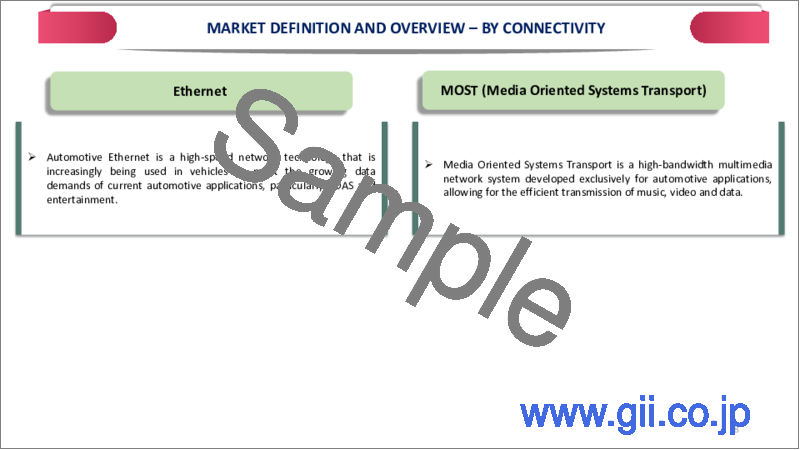|
|
市場調査レポート
商品コード
1459348
車載ネットワーキングの世界市場-2024-2031年Global In-Vehicle Networking Market - 2024-2031 |
||||||
カスタマイズ可能
適宜更新あり
|
|||||||
| 車載ネットワーキングの世界市場-2024-2031年 |
|
出版日: 2024年04月03日
発行: DataM Intelligence
ページ情報: 英文 210 Pages
納期: 即日から翌営業日
|
- 全表示
- 概要
- 目次
概要
世界の車載ネットワーキング市場は、2023年に21億米ドルに達し、2031年には36億米ドルに達すると予測され、予測期間2024-2031年のCAGRは7.2%で成長します。
車内をネットワーク化するシステムにより、アダプティブクルーズコントロール、車線逸脱警報、衝突回避、車車間通信など、セーフティクリティカルな機能の統合が可能になります。この機能により、自動車の安全性が向上し、事故の可能性が低下し、一般的な運転効果が高まる。自動車の安全性、排出ガス、コネクティビティ機能に関する厳しい規則や規制は、政府や規制当局によって課されています。必要な安全性と接続性の要素を自動車に統合することで、車載ネットワーキングシステムは自動車メーカーがこれらの基準を遵守するのを支援します。
主要プレーヤーによる製品投入の増加は、予測期間中の市場成長を後押しします。例えば、2023年11月08日、MaxLinear社は、民生用および産業用IoTアプリケーションをターゲットとしたシングルポート1GイーサネットPHYファミリを発表しました。この新ファミリは民生用と産業用のバリエーションがあり、ゲートウェイ、ルータ、産業用PC、メディアコンバータ、SGMII-RGMIIブリッジなど多様なアプリケーションに対応しています。製品には、使いやすさを追求した包括的なマニュアルと開発キットが付属しています。
アジア太平洋地域は、予測期間中に同地域の主要プレーヤーが技術的に先進的な製品を発売するようになったため、同市場において支配的な地域となっています。例えば、2023年3月31日、ソフトテックエンジニアズは、クラウドベースでAIを搭載した建設ERPソフトウェア「CivitBUILD」を発表しました。最近発表されたこのソリューションは、SaaSモデルに基づくクラウドベースの人工知能(AI)駆動型建設ERPで、インドの建築・エンジニアリング・建設セクターの成長をサポートします。
ダイナミクス
車載ネットワーキングの技術革新
高速通信プロトコルと車載イーサネットは、車載ネットワーク内でのデータ転送速度の高速化を可能にする技術進歩の一例です。これにより、無線アップデート、リアルタイムナビゲーション、ストリーミングビデオなどの広帯域アプリの統合が容易になり、ユーザーエクスペリエンスが全体的に向上し、車載ネットワーキングシステムの需要が高まる。ネットワーキング技術とプロトコルの革新により、車載ネットワーキングシステムの信頼性と性能が向上し、車内のさまざまな電子制御ユニット(ECU)とコンポーネント間のシームレスな通信が確保されます。この信頼性は、重要な安全システム、自律走行機能、リアルタイムの車両診断に不可欠であり、自動車メーカーや消費者の厳しい要求を満たすことで市場の成長を促進しています。
例えば、2023年06月08日、マーベル・テクノロジー社は、業界最高容量の車載ネットワーク用中央イーサネットスイッチを発表しました。このスイッチファミリーは、暗号化を強化し、中間者攻撃(man-in-the-middle)などの攻撃を阻止する高度なセキュリティ技術の数々を組み込んでいます。Brightlane Q622xスイッチファミリーは、市販のソリューションの約2倍の帯域幅を提供し、90 Gbpsという驚異的な容量を誇ります。
コネクテッドビークルに対する需要の高まり
顧客は、他の電子機器に匹敵するような接続機能を自動車に求め始めました。インフォテインメントシステム、ナビゲーション、スマートフォンとの統合、Wi-Fiホットスポット機能、リモートアクセス機能などはその一例です。高度な車載ネットワーキングシステムのニーズは、こうした特徴を備えたコネクテッドカーへのニーズによってもたらされています。リアルタイムの交通データ、天気予報、個別化されたエンターテインメントオプション、スマートフォンやその他のデバイスとのシームレスな統合をユーザーに提供することで、コネクテッドカーは運転体験を向上させる。これらの機能のシームレスな統合と通信は、車内ネットワーク技術によって可能になり、運転の利便性と楽しさを向上させています。
主要プレーヤーによる合併・買収戦略の高まりが、車載ネットワーキング市場の成長を後押ししています。例えば、コネクテッドビークルソリューションの世界的リーダーであるHARMANは、2024年2月26日、クアルコムと協力し、コネクテッドカー向けの新しいレディコネクト5G TCUで自動車の技術革新を推進しました。Snapdragon Auto 5G Modem-RF Gen 2をベースとするHARMAN Ready Connect 5G TCUは、自動車接続における大きな進展であり、OEMエンジニアの時間と労力を節約すると同時に、顧客に豊かな車内体験を提供します。
セキュリティとプライバシーに関する懸念
車載ネットワーク用システムは、ウイルス、ハッキング、不正アクセスなどのサイバーセキュリティリスクの影響を受けやすいです。こうしたリスクは、自動車の安全性、プライバシー、データの完全性を著しく損なう可能性があります。また、データの盗難、車両の遠隔操作、重要な車両システムの改ざんなどにもつながります。車載ネットワーキングシステムによって、車の健康状態や乗員、 促進要因の運転パターンに関する機密情報や個人情報を含む膨大な量のデータが収集・送信されます。こうしたデータの収集、保存、交換に利用される技術に対する懸念が、コネクテッドカーテクノロジーの採用を妨げています。
テレマティクス、無線アップグレード、車両へのリモートアクセスなどのコネクテッドサービスによって、さらなる安全リスクがもたらされます。悪意ある行為者は、これらのシステムの欠陥を利用して、自動車への不正アクセスを行ったり、自動車内部のソフトウェアやファームウェアの信頼性を損なったりしています。当局は、自動車におけるデータプライバシーとサイバーセキュリティに関してより厳格なガイドラインと基準を課すことで、プライバシーとセキュリティの懸念に対応しています。こうした規制を遵守することは、車載ネットワーキングシステムの開発と展開の詳細さとコストを増大させ、市場の拡大を阻害します。
目次
目次
第1章 調査手法と調査範囲
第2章 定義と概要
第3章 エグゼクティブサマリー
第4章 市場力学
- 影響要因
- 促進要因
- 車載ネットワークにおける技術革新
- コネクテッドカー需要の高まり
- 抑制要因
- セキュリティとプライバシーに関する懸念
- 機会
- 影響分析
- 促進要因
第5章 産業分析
- ポーターのファイブフォース分析
- サプライチェーン分析
- 価格分析
- 規制分析
- ロシア・ウクライナ戦争の影響分析
- DMIの見解
第6章 COVID-19分析
第7章 コネクティビティ別
- CAN
- LIN
- FlexRay
- RF
- Ethernet
- MOST
第8章 車両別
- 乗用車
- LCV
- HCV
- AGV
- その他
第9章 用途別
- パワートレイン
- セーフティ
- ボディエレクトロニクス
- シャシー
- インフォテインメント
- その他
第10章 地域別
- 北米
- 米国
- カナダ
- メキシコ
- 欧州
- ドイツ
- 英国
- フランス
- イタリア
- スペイン
- その他欧州
- 南米
- ブラジル
- アルゼンチン
- その他南米
- アジア太平洋
- 中国
- インド
- 日本
- オーストラリア
- その他アジア太平洋地域
- 中東・アフリカ
第11章 競合情勢
- 競合シナリオ
- 市況/シェア分析
- M&A分析
第12章 企業プロファイル
- Advanced Micro Devices, Inc.
- 会社概要
- 製品ポートフォリオと説明
- 財務概要
- 主な発展
- Bosch Limited
- Elmos Semiconductor SE
- Infineon Technologies AG
- Melexis.
- Microchip Technology Inc.
- NXP Semiconductors.
- STMicroelectronics
- Texas Instruments Incorporated
- Semiconductor Components Industries, LLC
第13章 付録
Overview
Global In-Vehicle Networking Market reached US$ 2.1 Billion in 2023 and is expected to reach US$ 3.6 Billion by 2031, growing with a CAGR of 7.2% during the forecast period 2024-2031.
Systems for networking vehicles inside the car make it possible to integrate safety-critical functions including adaptive cruise control, lane departure warning, collision avoidance and vehicle-to-vehicle communication. The characteristics improve car safety, lower the chance of accidents and boost general driving effectiveness. Strict rules and regulations on car safety, emissions and connectivity features are being imposed by governments and regulatory authorities. Through the integration of necessary safety and connectivity elements into their vehicles, in-vehicle networking systems assist automobile manufacturers in adhering to these standards.
Growing product launches by the major key players help to boost market growth over the forecast period. For instance, on November 08, 2023, MaxLinear launched the single-port 1G ethernet PHY family aimed at both consumer and industrial IoT applications. The new family is offered in consumer and industrial variations, catering to diverse applications including gateways, routers, industrial PCs, media converters and SGMII to RGMII bridges. The products come with comprehensive documentation and development kits for ease of use.
Asia-Pacific is the dominating region in the market due to the growing technologically advanced product launches by major key players in the region over the forecast period. For instance, on March 31, 2023, SoftTech Engineers launched CivitBUILD, an exclusive Cloud-based and AI-Powered Construction ERP Software. The recently introduced solution, a cloud-powered, artificial intelligence (AI)-driven construction ERP based on the SaaS model, supports the growth of India's architecture, engineering and construction sector.
Dynamics
Technological Innovations in the In-Vehicle Networking
High-speed communication protocols and automotive Ethernet are examples of technological advancements that allow for quicker data transfer rates inside the car network. The makes it easier to integrate high-bandwidth apps like over-the-air updates, real-time navigation and streaming video, improving user experience overall and increasing demand for in-vehicle networking systems. Innovations in networking technologies and protocols improve the reliability and performance of in-vehicle networking systems, ensuring seamless communication between various electronic control units (ECUs) and components within the vehicle. The reliability is essential for critical safety systems, autonomous driving features and real-time vehicle diagnostics, driving market growth by meeting the stringent requirements of automotive manufacturers and consumers.
For instance, on June 08, 2023, Marvell Technology, Inc. delivered the industry's highest capacity central automotive ethernet switches for in-vehicle networks. The Switch family incorporates a sophisticated array of security technologies to enhance encryption and thwart attacks such as man-in-the-middle and others. The Brightlane Q622x switch family provides almost double the bandwidth of commercially available solutions, boasting an impressive 90 Gbps capacity.
Rising Demand for Connected Vehicles
Customers started to demand connection features in cars that are comparable to those seen in other electronic devices. Infotainment systems, navigation, smartphone integration, Wi-Fi hotspot capabilities and remote access functions are some examples of these features. The need for sophisticated in-car networking systems is driven by the need for connected automobiles with these characteristics. By providing users access to real-time traffic data, weather reports, individualized entertainment options and seamless smartphone and other device integration, connected cars improve the driving experience. The seamless integration and communication of these functions are made possible by in-car networking technologies, which enhance the convenience and enjoyment of driving.
Growing merger and acquisition strategies by major key players help to boost the market growth of the In-Vehicle networking market. For instance, on February 26, 2024, HARMAN, a global leader in connected vehicle solutions worked with Qualcomm to drive automotive innovation with a new ready-connect 5G TCU for connected cars. The HARMAN Ready Connect 5G TCU, which is based on the Snapdragon Auto 5G Modem-RF Gen 2, is a major development in automotive connection that will save OEM engineers time and effort while providing rich in-cabin experiences for customers.
Security and Privacy Concerns
Systems for in-car networking are susceptible to viruses, hacking and illegal access, among other cybersecurity risks. The risks have the potential to severely compromise car safety, privacy and data integrity. It also results in data theft, remote vehicle control or tampering with vital vehicle systems. Huge quantities of data are gathered and sent by in-vehicle networking systems, including sensitive and private information on the health of the car, the occupants and the driving patterns of the driver. Concerns over the techniques utilized to collect, store and exchange this data are impeding the adoption of connected automobile technology.
Additional safety risks are introduced by connected services like telematics, over-the-air upgrades and remote vehicle access. Malicious actors take advantage of these systems' flaws to obtain illegal access to cars or compromise the reliability of the software and firmware inside them. Authorities are responding to privacy and security concerns by imposing stricter guidelines and standards on data privacy and cybersecurity in automobiles. Compliance with these regulations increases the level of detail and cost of in-vehicle networking system development and deployment, thus impeding the market's expansion.
Segment Analysis
The global In-vehicle networking market is segmented based on connectivity, vehicle, application and region.
Growing Adoption of Passenger Cars Globally
Based on the vehicle, the In-vehicle networking market is segmented into passenger cars, light commercial vehicles, heavy commercial vehicles, automated guided vehicles and others. The demand for connected features in cars is growing among consumers; these features include internet access, smartphone integration, improved entertainment systems and navigation. The integration of these elements improves passenger convenience and the driving experience via in-car networking systems. As several passenger vehicles are growing globally the demand for the In-vehicle networking market is growing.
The growing passenger car sales across the world help to boost segment growth over the forecast period. For instance, according to the data given by, the global economy the average for 2022 based on 57 countries was 988605 passenger cars. China accounted largest market share in the sales of passenger cars globally, selling around 23563287 passenger cars and India sold around 3792356 passenger cars.
Geographical Penetration
Asia-Pacific is Dominating the In-Vehicle Networking Market
The Asia-Pacific has experienced rapid economic growth, which has raised urbanization and disposable income levels. The market for in-vehicle networking solutions is being pushed by the rising demand for automobiles as a result of this expansion, including trucks, passenger cars, and electric vehicles. The region is a major hub for the manufacturing of automobiles, home to major automakers from China, Japan, South Korea and India. Due to large R&D investments in the region's automotive sector, modern technology, particularly in-vehicle networking systems, has become simpler to incorporate into locally constructed automobiles.
The demand for hybrid and electric automobiles is expanding rapidly in the Asia-Pacific. The demand for in-car networking systems made specifically for electric drivetrains and battery management is being driven by governments in countries like South Korea, China, Japan and others who are enacting laws and incentives to encourage the use of electric vehicles. As to the weekly article, India's EV adoption rate is expected to increase by 82% by March 2023. Over one lakh EVs are expected to be sold each month in 2023, indicating the substantial increase the electric two-wheeler operations are seeing.
Competitive Landscape.
The major global players in the market include Advanced Micro Devices, Inc., Bosch Limited, Elmos Semiconductor SE, Infineon Technologies AG, Melexis., Microchip Technology Inc., NXP Semiconductors., STMicroelectronics, Texas Instruments Incorporated and Semiconductor Components Industries, LLC.
COVID-19 Impact Analysis
The pandemic's impact on international supply chains changed way car parts were made and sold, particularly those used in in-vehicle networking systems. Reductions in labor, limitations on transportation and closures of factories were some of the main factors contributing to shortages and delays of essential components. Lockdowns and social distance have prompted several auto plants across the world to temporarily limit or stop operations. Delays in automobile production resulted from this, which affected the incorporation of in-vehicle networking equipment into newly manufactured automobiles.
Priorities among consumers changed as a result of the pandemic's effects on lifestyle and the economy. The total market for in-vehicle networking systems was impacted by customers delaying non-essential purchases, which resulted in a decline in demand for new automobiles. The epidemic raised interest in linked and self-driving car technology. In-car networking systems, that offer connection, entertainment and remote monitoring capabilities, have become more important as individuals have evolved to working remotely and have looked for contactless solutions.
Russia-Ukraine War Impact Analysis
In the global automotive supply chain, which includes electronic components used in in-vehicle networking systems, Russia and Ukraine play a significant role. Any disturbances to the store network, such as active stoppages, send-out refusals or transportation delays that result in a shortage of critical parts, would impact the assembly of vehicles equipped with in-vehicle organizing frameworks. Businesses in the in-vehicle networking sector find it more challenging to make long-term investment choices due to geopolitical volatility, which affects their growth and expansion plans.
International strains and monetary approvals forced because of the conflict cause cash trade rates to differ, especially for the Russian ruble and Ukrainian hryvnia. Currency exchange rate fluctuations affect the price of imported components and materials for in-vehicle networking systems, which affects the income of manufacturers and suppliers. The market for in-vehicle networking systems was impacted by short-term challenges in the automotive manufacturing sector brought on by the conflict, such as labor shortages, plant closures or supply chain problems.
By Connectivity
- Controller Area Network (CAN)
- Local Interconnect Network (LIN)
- FlexRay
- Radio Frequency
- Ethernet
- MOST (Media Oriented Systems Transport)
By Vehicle
- Passenger Car
- Light commercial vehicle
- Heavy Commercial Vehicle
- Automated Guided Vehicle
- Others
By Application
- Powertrain
- Safety
- Body Electronics
- Chassis
- Infotainment
- Others
By Region
- North America
- U.S.
- Canada
- Mexico
- Europe
- Germany
- UK
- France
- Italy
- Spain
- Rest of Europe
- South America
- Brazil
- Argentina
- Rest of South America
- Asia-Pacific
- China
- India
- Japan
- Australia
- Rest of Asia-Pacific
- Middle East and Africa
Key Developments
- On November 18, 2021, Elektrobit launched the industry-first automotive ethernet switch firmware for high-performance and secure in-vehicle communication. It is available for the top automotive switches. It helps to car manufacturers to accelerate the production of next-gen vehicles.
- On July 06, 2023, TTTech Auto, a technology leader in automotive safety software and ZettaScale extended their collaboration and launched Zetta Auto, a unified solution for in-vehicle and V2X communication.
- On September 18, 2023, Saudi Arabia, announced a launch of 5.9 gigahertz bandwidth for "vehicle-to-everything" technology. V2X technology utilizes sensors, cameras and wireless connectivity to enable communication between car drivers, co-drivers, pedestrians and even traffic lights.
Why Purchase the Report?
- To visualize the global In-vehicle networking market segmentation based on connectivity, vehicle, application and region, as well as understand key commercial assets and players.
- Identify commercial opportunities by analyzing trends and co-development.
- Excel data sheet with numerous data points of In-Vehicle Networking market-level with all segments.
- PDF report consists of a comprehensive analysis after exhaustive qualitative interviews and an in-depth study.
- Product mapping available as excel consisting of key products of all the major players.
The global in-vehicle networking market report would provide approximately 62 tables, 60 figures and 210 Pages.
Target Audience 2024
- Manufacturers/ Buyers
- Industry Investors/Investment Bankers
- Research Professionals
- Emerging Companies
Table of Contents
Table of Contents
1.Methodology and Scope
- 1.1.Research Methodology
- 1.2.Research Objective and Scope of the Report
2.Definition and Overview
3.Executive Summary
- 3.1.Snippet by Connectivity
- 3.2.Snippet by Vehicle
- 3.3.Snippet by Application
- 3.4.Snippet by Region
4.Dynamics
- 4.1.Impacting Factors
- 4.1.1.Drivers
- 4.1.1.1.Technological Innovations in the In-Vehicle Networking
- 4.1.1.2.Rising Demand for Connected Vehicles
- 4.1.2.Restraints
- 4.1.2.1.Security and Privacy Concerns
- 4.1.3.Opportunity
- 4.1.4.Impact Analysis
- 4.1.1.Drivers
5.Industry Analysis
- 5.1.Porter's Five Force Analysis
- 5.2.Supply Chain Analysis
- 5.3.Pricing Analysis
- 5.4.Regulatory Analysis
- 5.5.Russia-Ukraine War Impact Analysis
- 5.6.DMI Opinion
6.COVID-19 Analysis
- 6.1.Analysis of COVID-19
- 6.1.1.Scenario Before COVID
- 6.1.2.Scenario During COVID
- 6.1.3.Scenario Post COVID
- 6.2.Pricing Dynamics Amid COVID-19
- 6.3.Demand-Supply Spectrum
- 6.4.Government Initiatives Related to the Market During Pandemic
- 6.5.Manufacturers Strategic Initiatives
- 6.6.Conclusion
7.By Connectivity
- 7.1.Introduction
- 7.1.1.Market Size Analysis and Y-o-Y Growth Analysis (%), By Connectivity
- 7.1.2.Market Attractiveness Index, By Connectivity
- 7.2.Controller Area Network (CAN)*
- 7.2.1.Introduction
- 7.2.2.Market Size Analysis and Y-o-Y Growth Analysis (%)
- 7.3.Local Interconnect Network (LIN)
- 7.4.FlexRay
- 7.5.Radio Frequency
- 7.6.Ethernet
- 7.7.MOST (Media Oriented Systems Transport)
8.By Vehicle
- 8.1.Introduction
- 8.1.1.Market Size Analysis and Y-o-Y Growth Analysis (%), By Vehicle
- 8.1.2.Market Attractiveness Index, By Vehicle
- 8.2.Passenger Car*
- 8.2.1.Introduction
- 8.2.2.Market Size Analysis and Y-o-Y Growth Analysis (%)
- 8.3.Light commercial vehicle
- 8.4.Heavy Commercial Vehicle
- 8.5.Automated Guided Vehicle
- 8.6.Others
9.By Application
- 9.1.Introduction
- 9.1.1.Market Size Analysis and Y-o-Y Growth Analysis (%), By Application
- 9.1.2.Market Attractiveness Index, By Application
- 9.2.Powertrain*
- 9.2.1.Introduction
- 9.2.2.Market Size Analysis and Y-o-Y Growth Analysis (%)
- 9.3.Safety
- 9.4.Body Electronics
- 9.5.Chassis
- 9.6.Infotainment
- 9.7.Others
10.By Region
- 10.1.Introduction
- 10.1.1.Market Size Analysis and Y-o-Y Growth Analysis (%), By Region
- 10.1.2.Market Attractiveness Index, By Region
- 10.2.North America
- 10.2.1.Introduction
- 10.2.2.Key Region-Specific Dynamics
- 10.2.3.Market Size Analysis and Y-o-Y Growth Analysis (%), By Connectivity
- 10.2.4.Market Size Analysis and Y-o-Y Growth Analysis (%), By Vehicle
- 10.2.5.Market Size Analysis and Y-o-Y Growth Analysis (%), By Application
- 10.2.6.Market Size Analysis and Y-o-Y Growth Analysis (%), By Country
- 10.2.6.1.U.S.
- 10.2.6.2.Canada
- 10.2.6.3.Mexico
- 10.3.Europe
- 10.3.1.Introduction
- 10.3.2.Key Region-Specific Dynamics
- 10.3.3.Market Size Analysis and Y-o-Y Growth Analysis (%), By Connectivity
- 10.3.4.Market Size Analysis and Y-o-Y Growth Analysis (%), By Vehicle
- 10.3.5.Market Size Analysis and Y-o-Y Growth Analysis (%), By Application
- 10.3.6.Market Size Analysis and Y-o-Y Growth Analysis (%), By Country
- 10.3.6.1.Germany
- 10.3.6.2.UK
- 10.3.6.3.France
- 10.3.6.4.Italy
- 10.3.6.5.Spain
- 10.3.6.6.Rest of Europe
- 10.4.South America
- 10.4.1.Introduction
- 10.4.2.Key Region-Specific Dynamics
- 10.4.3.Market Size Analysis and Y-o-Y Growth Analysis (%), By Connectivity
- 10.4.4.Market Size Analysis and Y-o-Y Growth Analysis (%), By Vehicle
- 10.4.5.Market Size Analysis and Y-o-Y Growth Analysis (%), By Application
- 10.4.6.Market Size Analysis and Y-o-Y Growth Analysis (%), By Country
- 10.4.6.1.Brazil
- 10.4.6.2.Argentina
- 10.4.6.3.Rest of South America
- 10.5.Asia-Pacific
- 10.5.1.Introduction
- 10.5.2.Key Region-Specific Dynamics
- 10.5.3.Market Size Analysis and Y-o-Y Growth Analysis (%), By Connectivity
- 10.5.4.Market Size Analysis and Y-o-Y Growth Analysis (%), By Vehicle
- 10.5.5.Market Size Analysis and Y-o-Y Growth Analysis (%), By Application
- 10.5.6.Market Size Analysis and Y-o-Y Growth Analysis (%), By Country
- 10.5.6.1.China
- 10.5.6.2.India
- 10.5.6.3.Japan
- 10.5.6.4.Australia
- 10.5.6.5.Rest of Asia-Pacific
- 10.6.Middle East and Africa
- 10.6.1.Introduction
- 10.6.2.Key Region-Specific Dynamics
- 10.6.3.Market Size Analysis and Y-o-Y Growth Analysis (%), By Connectivity
- 10.6.4.Market Size Analysis and Y-o-Y Growth Analysis (%), By Vehicle
- 10.6.5.Market Size Analysis and Y-o-Y Growth Analysis (%), By Application
11.Competitive Landscape
- 11.1.Competitive Scenario
- 11.2.Market Positioning/Share Analysis
- 11.3.Mergers and Acquisitions Analysis
12.Company Profiles
- 12.1.Advanced Micro Devices, Inc.*
- 12.1.1.Company Overview
- 12.1.2.Product Portfolio and Description
- 12.1.3.Financial Overview
- 12.1.4.Key Developments
- 12.2.Bosch Limited
- 12.3.Elmos Semiconductor SE
- 12.4.Infineon Technologies AG
- 12.5.Melexis.
- 12.6.Microchip Technology Inc.
- 12.7.NXP Semiconductors.
- 12.8.STMicroelectronics
- 12.9.Texas Instruments Incorporated
- 12.10.Semiconductor Components Industries, LLC
LIST NOT EXHAUSTIVE
13.Appendix
- 13.1.About Us and Services
- 13.2.Contact Us






